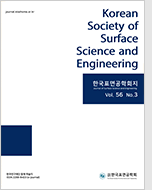
- Past Issues
- e-Submission
-

2021 Impact Factor 1.766
5-Year Impact Factor 1.674
Editorial Office
- +82-2-563-0935
- +82-2-558-2230
- submission@kssse.or.kr
- https://www.kssse.or.kr/

2021 Impact Factor 1.766
5-Year Impact Factor 1.674
The Korean Society of Surface Science and Engineering 2023;56(2):147-151. Published online: May, 2, 2023
DOI : /10.5695/JSSE.2023.56.2.147
Transparent ZnO (100 nm thick) and ZnO/Ti/ZnO (ZTZ) films were prepared with radio frequency (RF) and direct current (DC) magnetron sputtering on the glass substrate at room temperature. During the ZTZ film deposition, the thickness of the Ti interlayer was varied, such as 6, 9, 12, and 15 nm, while the thickness of ZnO films was kept at 50 nm to investigate the effect of the Ti interlayer on the crystallization and opto-electrical performance of the films. From the XRD pattern, it is concluded that the 9 nm thick Ti interlayer showed some characteristic peaks of Ti (200) and (220), and the grain size of the ZnO (002) enlarged from 13.32 to 15.28 nm as Ti interlayer thickness increased. In an opto-electrical performance observation, ZnO single-layer films show a figure of merit of 1.4×10-11 Ω-1, while ZTZ films with a 9 nm-thick Ti interlayer show a higher figure of merit of 2.0×10-5 Ω-1.
Keywords ZnO; Ti; XRD; AFM; Figure of merit.